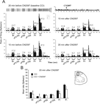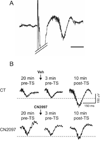A cyclic peptide targeted against PSD-95 blocks central sensitization and attenuates thermal hyperalgesia
- PMID: 20167266
- PMCID: PMC2849898
- DOI: 10.1016/j.neuroscience.2010.02.031
A cyclic peptide targeted against PSD-95 blocks central sensitization and attenuates thermal hyperalgesia
Abstract
Post-synaptic density protein PSD-95 is emerging as a valid target for modulating nociception in animal studies. Based on the key role of PSD-95 in neuronal plasticity and the maintenance of pain behavior, we predicted that CN2097, a peptide-based macrocycle of nine residues that binds to the PSD-95 Discs large, Zona occludens 1 (PDZ) domains of PSD-95, would interfere with physiologic phenomena in the spinal cord related to central sensitization. Furthermore, we tested whether spinal intrathecal injection of CN2097 attenuates thermal hyperalgesia in a rat model of sciatic neuropathy. Results demonstrate that spinal CN2097 reverses hyperexcitability of wide dynamic range (WDR) neurons in the dorsal horn of neuropathic rats and decreases their evoked responses to peripheral stimuli (brush, low caliber von Frey and pressure), whereas CN5125 ("negative control") has no effect. CN2097 also blocks C-fiber long-term potentiation (LTP) in the dorsal horn, which is linked to neuronal plasticity and central sensitization. At a molecular level, CN2097 attenuates the increase in phosphorylated p38 MAPK, a key intracellular signaling pathway in neuropathic pain. Moreover, spinal injection of CN2097 blocks thermal hyperalgesia in neuropathic rats. We conclude that CN2097 is a small molecule peptide with putative anti-nociceptive effects that modulates physiologic phenomena related to central sensitization under conditions of chronic pain.
(c) 2010 IBRO. Published by Elsevier Ltd. All rights reserved.
Figures








References
-
- Afrah AW, Fiska A, Gjerstad J, Gustafsson H, Tjolsen A, Olgart L, Stiller CO, Hole K, Brodin E. Spinal substance P release in vivo during the induction of long-term potentiation in dorsal horn neurons. Pain. 2002;96:49–55. - PubMed
-
- Arendt-Nielsen L, Petersen-Felix S, Fischer M, Bak P, Bjerring P, Zbinden AM. The effect of N-methyl-D-aspartate antagonist (ketamine) on single and repeated nociceptive stimuli: a placebo-controlled experimental human study. Anesth Analg. 1995;81:63–68. - PubMed
-
- Bennett GJ, Xie YK. A peripheral mononeuropathy in rat that produces disorders of pain sensation like those seen in man. Pain. 1988;33:87–107. - PubMed
-
- Campbell JN, Raja SN, Meyer RA, Mackinnon SE. Myelinated afferents signal the hyperalgesia associated with nerve injury. Pain. 1988;32:89–94. - PubMed
Publication types
MeSH terms
Substances
Grants and funding
LinkOut - more resources
Full Text Sources
Other Literature Sources

